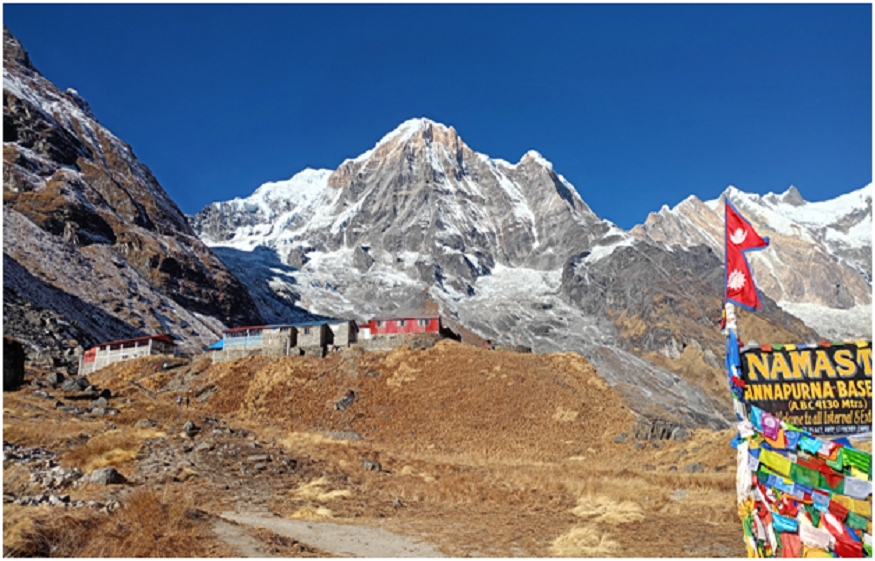Annapurna Base Camp Trekking
The Annapurna Base Camp trekking is a classic Himalayan enterprise that draws trekkers from all over the world. This relaxing trip takes you deep into the heart of the Annapurna Haven, a breathtaking amphitheater of towering peaks, counting Annapurna I (8,091m), the tenth-highest mountain in the world. The trek offers a differing extent of scenery, from lavish subtropical timberlands and terraced farmland to elevated glades and cold moraines. As you climb, you will pass through conventional Gurung and Magar towns where you can involve the wealthy social legacy and warm neighborliness of the neighborhood individuals. The path is too embellished with rhododendron timberlands, which blossom in dynamic tones amid the spring season, making a pleasant trekking route.
Starting from the bustling town of Pokhara, the trek regularly takes 7 to 12 days depending on your pace and schedule. It takes after a well-established course through towns like Chhomrong and Deurali some time recently coming full circle at Annapurna Base Camp (4,130m). Along the way, trekkers are rewarded with all encompassing views of magnificent peaks such as Machapuchare (Fishtail Mountain), Annapurna South, and Hiunchuli. The Annapurna Base Camp trek is appropriate for both prepared globe-trotters and first-time trekkers due to its direct trouble level. With appropriate planning and acclimatization, it is an achievable and monstrously fulfilling encounter that combines common magnificence with social immersion.
Kathmandu Shivapuri National Park and Nagarkot Hiking
Kathmandu, the capital city of Nepal, offers a mix of antiquated culture and normal excellence. One of the best ways to involve its quiet scenes is through climbing in Kathmandu Shivapuri National Park and Nagarkot Hiking . Found on the northern periphery of Kathmandu Valley, Shivapuri National Park is a safe house for nature darlings. The stop is domestic to differing greenery and fauna, counting panthers, Himalayan dark bears, and over 300 species of feathered creatures. The trails through the stop offer a quiet withdrawal from the city, with thick woodlands, cascading waterfalls, and staggering mountain vistas.
The climb to Nagarkot, arranged at an height of 2,175m, is another prevalent choice for those looking for all encompassing sees of the Himalayas. From the ridge, guests can witness awe-inspiring dawns over peaks like Langtang, Ganesh Himal, and indeed Mount Everest on clear days. The course to Nagarkot offers a wonderful combination of tender climbs and forested ways, making it open to climbers of different wellness levels. This trek regularly takes 2 to 3 days and is a great choice for those who need to encounter the excellence of the Himalayas without wandering as well distant from Kathmandu.
Kathmandu Valley View
The Kathmandu Valley is a social and verifiable treasure trove, encompassed by rolling slopes and snow-capped mountains. Investigating the valley offers a special mix of characteristic excellence and UNESCO World Legacy Destinations. The valley is home to old cities like Kathmandu, Bhaktapur, and Patan, each gloating complicated engineering, centuries-old sanctuaries, and dynamic neighborhood markets. A valley-view trek gives an opportunity to investigate the provincial edges, where terraced areas, conventional towns, and quiet cloisters make a captivating backdrop.From vantage focuses like Phulchowki, Chandragiri, and Dhulikhel, trekkers can appreciate clearing sees of the Himalayan run whereas drenching themselves in neighborhood culture. The valley offers various day climbs and multi-day trekking choices that cater to distinctive wellness levels and interface. Whether you’re walking through memorable Durbar Squares or rising to peak perspectives, the Kathmandu Valley guarantees an exceptional travel through Nepal’s social heartland.
White-Water Trishuli River Rafting
For enterprise devotees, White-Water Trishuli River Rafting is an exciting encounter. Streaming from the tall Himalayas, the Trishuli Stream offers a culminating mix of exciting rapids and beautiful excellence. This stream is named after the trident of Ruler Shiva, reflecting its otherworldly importance. The rafting trip ordinarily starts from Charaudi, around a three-hour drive from Kathmandu, and extends over 15 to 60 kilometers, depending on the chosen itinerary.
The Trishuli Stream highlights rapids extending from Review II to Review IV, giving energy for both fledglings and experienced rafters. Along the way, you’ll explore twirling streams, rough gorges, and calm stretches where you can appreciate the encompassing scenes. The riverbanks are embellished with terraced farmland, rich timberlands, and farther towns, advertising impressions of provincial Nepalese life. A normal Trishuli rafting trip keeps going one to three days and can be combined with other enterprises such as canyoning or investigating adjacent social regions. This exciting movement is a must-do for anybody looking for an adrenaline surge and a special point of view of Nepal’s common beauty.
Why Select These Treks
These treks and experiences offer an idealized combination of social investigation and characteristic excellence, making them perfect for travelers looking for a different Himalayan encounter. The Annapurna Base Camp trek permits you to submerge yourself in the magnificence of the mountains whereas encountering the warmth of neighborhood communities. Shivapuri National Park and Nagarkot climbing offer a reviving elude from urban life with their quiet scenes and all encompassing sights. The Kathmandu Valley View trek gives a profound social plunge into Nepal’s wealthy history and building wonders. In the meantime, Trishuli Waterway rafting includes an adrenaline-pumping measurement to your Himalayan travel. Together, these encounters give a comprehensive enterprise that caters to nature darlings, social devotees, and thrill-seekers alike.
Best Time for These Treks
The best time to attempt these Himalayan undertakings is amid the spring (Walk to May) and harvest time (September to November) seasons. Amid these months, the climate is for the most part steady with clear skies and direct temperatures, advertising perfect conditions for trekking and rafting. Spring brings sprouting rhododendrons and rich greenery, whereas harvest time offers fresh discussion and dazzling mountain perceivability. Winter (December to February) can be cold, particularly at higher heights, but it offers calmer trails and snow-covered scenes. The storm season (June to Eminent) is less favorable due to overwhelming precipitation and dangerous trails, in spite of the fact that it does improve the excellence of the timberlands and waterfalls.
Cost and Budgeting of These Treks
The fetch of these undertakings changes depending on the length, level of consolation, and administrations included. The Annapurna Base Camp trek ordinarily costs between $800 to $1,500, covering grants, guides, convenience, and suppers. Kathmandu valley climbs and Nagarkot trips run from $150 to $400 for a 2-3 day bundle. Trishuli Stream rafting costs around $70 to $150 for a day trip, counting transportation, security equipment, and suppers. Budgeting ought to moreover account for extra costs such as travel protections, equipment rental, and individual investing. Picking for a gathering visit can decrease costs whereas upgrading the involvement through shared camaraderie.
Health and Safety
Maintaining wellbeing and security is vital amid these treks. Legitimate acclimatization is basic for high-altitude regions like Annapurna Base Camp to avoid height ailment. Carrying a to begin with help pack, remaining hydrated, and taking after your guide’s counsel are imperative for a secure travel. For exercises like rafting, utilizing certified gear and following security conventions guarantees a secure involvement. It’s fitting to have comprehensive travel protections covering therapeutic departure and crisis protection. Normal physical planning, counting cardio and quality preparation, improves stamina and decreases the hazard of injury.
Sustainability and Responsible Trekking
Responsible trekking includes minimizing natural affect and supporting nearby communities. Taking after Take off No Follow standards, such as carrying out squander and regarding natural life, makes a difference to protect Nepal’s flawless scenes. Choosing locally-owned lodges and contracting nearby guides advances economical tourism and bolsters the economy. Travelers are empowered to decrease plastic use by carrying reusable water bottles and decontaminating water instead of buying bottled water. Social affectability, counting regarding nearby traditions and dressing unassumingly, cultivates positive intelligence and guarantees an aware trekking experience.
Tips to Make a Special Tour
To make your Himalayan experience genuinely uncommon, arrange ahead and customize your schedule to adjust with your interface. Locking in with nearby communities through homestays or social encounters upgrades the realness of your travel. Capture recollections by bringing a great camera, but moreover take time to disengage and submerge yourself in the common excellence. Consider combining numerous undertakings, such as trekking and rafting, for a differing encounter. Remaining adaptable with your plan permits you to grasp unconstrained openings, whether it’s going to a neighborhood celebration or investigating covered up trails.
Conclusion
The Himalayan trek through Annapurna, Kathmandu, and Trishuli offers an exceptional mix of experience, culture, and characteristic excellence. Whether you’re trekking to the magnificent Annapurna Base Camp, investigating the peaceful trails of Shivapuri and Nagarkot, marveling at Kathmandu Valley’s social legacy, or exploring the exciting rapids of the Trishuli Stream, each encounter guarantees enduring recollections. With keen arranging, capable phones, and a soul of enterprise, these ventures give an unparalleled opportunity to investigate the heart of Nepal.
FAQs
1. What level of wellness is required for these treks?
Moderate wellness is required for all these treks. Standard cardio and quality preparation some time recently your trip can improve your stamina.
2. Do I require grants for these treks?
Yes, grants such as the Annapurna Preservation Range permit (ACAP) and Trekkers’ Data Administration Framework (TIMS) card are required for the Annapurna Base Camp trek.
3. Is earlier rafting encounter fundamental for Trishuli River?
No, earlier encounters are not required. Certified guides give security briefings and information for beginners.
4. What is the settlement like on these treks?
Accommodation ranges from teahouses and guesthouses in trekking ranges to comfortable lodgings in Kathmandu.
5. How can I guarantee dependable trekking?
Follow Take off No Follow standards, back nearby businesses, and minimize plastic utilization to trek mindfully.
Booking Process byTrekking Guide Team Adventure :
To book any of these treks tours through Trekking Guide Team Adventure Pvt. Ltd., begin by contacting them via email at [email protected] or phone or WhatsApp at +977 9851229400 to discuss your preferred dates, group size, and specific needs. They will provide a detailed itinerary covering these trek’s duration, highlights, cost, and inclusions such as a guide, porter, meals, accommodation, and transportation.
Prior to the trek, you will receive a comprehensive pre-trek briefing with essential information on packing, fitness preparation, and altitude acclimatization. The agency will finalize all logistical arrangements, including transportation, accommodation, and permits, to ensure everything is in place for your trek. Upon arrival in Nepal, the team will ensure that all aspects of the trek are organized, providing you with a smooth and unforgettable experience on these treks.

